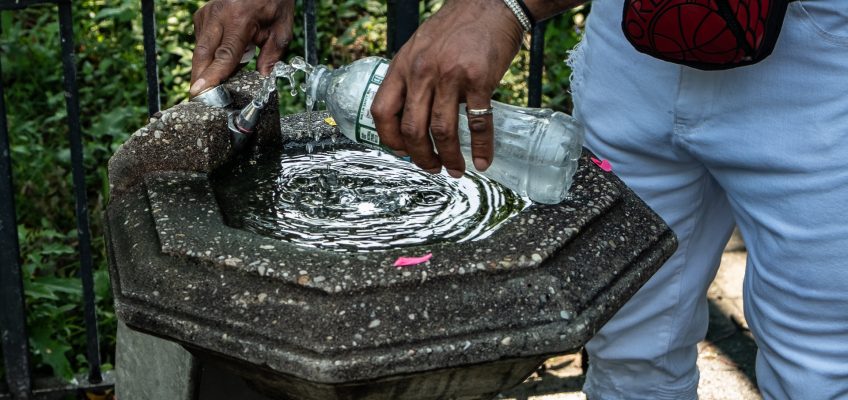As New York makes progress on stopping contamination from long-lasting chemicals known as PFAS, the Environmental Protection Agency is back-tracking on a recent federal regulation that set tighter limits for these chemicals in drinking water.
A drinking fountain at Mount Hope Playground in the Bronx. (Photo by Adi Talwar)
The U.S. Environmental Protection Agency (EPA) announced Wednesday that it plans to rescind and reconsider allowable levels of four long-lasting chemicals, known as PFAS, in drinking water—overturning regulations set by the Biden administration last spring. And utility companies will get a two-year extension to comply with previously-set standards for two other types of PFAS, officials said.
In response, environmental groups are urging Gov. Kathy Hochul to counteract the federal government’s decision by tightening PFAS regulations at home. They want New York’s rules to match the stricter limits set by the Biden administration last year.
“The Trump administration’s rollback on drinking water standards puts New Yorkers’ well-being and safety at risk,” a spokesperson for the governor said in an email, without commenting on calls to strengthen state rules.
PFAS, often called “forever chemicals” because they don’t break down easily, are commonly used to stain-proof and waterproof goods, including non-stick pans, clothing, menstrual products, cosmetics and firefighting foams.
But continued exposure to PFAS can lead to health issues, from increasing the risk of certain cancers to immune system deficiencies and developmental delays in children.
In April of last year, the EPA under Biden tightened limits on the amount of PFAS chemicals that can be present in drinking water, and gave utilities until 2029 to comply. To meet the new requirements, public utility water systems would need to inform the public of the level of PFAS measured in their drinking water. If those levels exceed established limits, they need to install filtration technologies to remove the chemicals or find alternative water sources.
The move was historic as it was the first time the agency had set enforceable limits on PFAS in drinking water.
But the Trump administration has since extended the compliance deadline for the Biden-era rule for two of the most common PFAS chemicals (PFOA and PFOS) to 2031. And it reconsidered the limits listed in the initial regulation for four other chemicals (PFHxS, PFNA, HFPO-DA, and PFBS). The agency plans to issue a proposed rule for those new limits this fall, and finalize it in the spring of 2026, according to a press release.
“The work to protect Americans from PFAS in drinking water started under the first Trump Administration and will continue under my leadership,” the head of the EPA, Lee Zeldin, said in a statement.
But the environmental community in New York says the decision is detrimental to progress being made to protect communities from these chemicals, which the Empire State has been passing laws to phase out.
“Delay puts people at risk of exposure to contaminants in drinking water and increases their risk for a variety of health problems—plain and simple,” said Shannon Roback, science director at the environmental organization Riverkeeper.
Roback says updating state-level drinking water standards to mirror the EPA’s more protective original proposal could help New York build on its progress in phasing out PFAS contamination altogether.
New York has been phasing out the use of PFAS in certain goods, and passed tight restrictions on their presence in drinking water in 2020. (Photo by Jeanmarie Evelly)
Over the last decade, New York has been steadily tightening regulations against these chemicals and has become, according to experts, a national leader in cracking down on the use of PFAS.
In 2020, New York adopted some of the nation’s lowest drinking water limits for the presence of two of the most common types of PFAS, known as PFOA and PFOS. And the New York State budget approved earlier this month included a ban on the use of PFAS in firefighting gear.
The PFAS-Free NY Campaign backs at least five additional bills this legislative session to crack down on the use of these chemicals. That includes legislation that would ban PFAS in household goods, one that would get rid of it in menstrual products and another that would regulate its use in cosmetics.
New York already bans these chemicals in certain products: there is one law on the books that prohibits carpets, including artificial turf, from containing PFAS. And there are others that prohibit its use in clothing or apparel, in food packaging and firefighter foam.
“New York has been a leader in addressing PFAS pollution,” said Rob Hayes, senior director of clean water at Environmental Advocates NY.
Hayes says the rollback on the EPA’s drinking water standards for PFAS won’t impact New York City, where the drinking water currently meets even the more stricter levels set under Biden.
But at least 1.3 million New York residents will be exposed to PFAS contamination, according to a recent report by the Environmental Working Group. That’s because there are 189 New York water systems—primarily serving residents on Long Island—that don’t meet the standard, the report notes.
Still, Hayes says that relaxing any PFAS rules now could lead New York down a dangerous path, and that tightening drinking water regulations on the state level could guarantee New Yorkers stay protected.
“When the federal government fails us, New York state authorities have to step up to protect us,” Hayes said.
“If the use of PFAS chemicals in products and in manufacturing processes continues, it’s possible that down the line the [city’s] drinking water could become polluted too, and it’s another reason why we have to turn off the tap on these chemicals entirely.”
To reach the reporter behind this story, contact Mariana@citylimits.org. To reach the editor, contact Jeanmarie@citylimits.org
Want to republish this story? Find City Limits’ reprint policy here.
The post After Feds Weaken Drinking Water Standards, NY Environmentalists Call for Tighter Regulations At Home appeared first on City Limits.


Leave a Reply